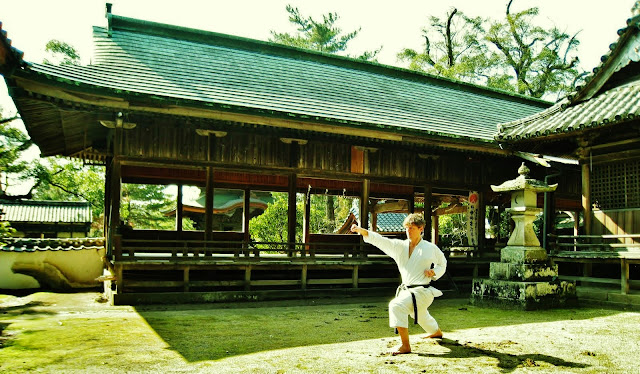This brief article will address the timing of 受け技 (ukewaza) in relation to
footwork and ‘the double action’ of the foundational ‘reception techniques’.
To begin we must first consider the pragmatic function of
ukewaza from a vantage point that the karateka has sufficiently mastered the
movement(s).
I’d like to do this by repeating a statement that I’ve
stated countless times before: “I’ve never seen a ‘block’ used in a real
fight”. Nor have I ever used one in my decade of security work in bars, clubs,
and as a bodyguard, where I had numerous violent confrontations on a regular basis (I must add
here, that as a bodyguard, I fortunately never had not even one physical incident).
So, as the term ‘uke’ means ‘reception’/to receive, I can
say that I have utilized free versions of these waza on a regular basis;
moreover, when done correctly—and their universal defensive principles are
understood and applied—the Shotokan ukewaza are highly effective in the real
world.
That being said, and as stated in my opening words, the
‘timing’ of all ukewaza is utterly imperative to make them useful outside of
the dojo. And yes, they are VERY USEFUL.
To address this, I’ll begin with the other point I
mentioned: the double action.
1. The
‘Double Action’
It is obvious that the wind up/chambering of the
foundational ukewaza makes no sense against a sudden single action, let alone a
barrage of attacks. Simply put, the punch or strike is immediate and direct,
and therefore intrinsically faster. Consequently, the completed ‘uke’ cannot
out-speed such a single action—especially when it is completely
unpredictable—which is always the case in a ‘jiyu context’ (jiyu kumite, goshin
jutsu, police/security/military).
Common sense immediately shows that this is not the true
meaning of these waza. Accordingly, we know that “…the ‘wind up’/‘chambering’
is the reactive response to the respective stimuli”. With that cleared up, “the
second action, the completion of the waza, is thus achieving ‘kime’ as a
secondary defense; a counterattack; or both simultaneously”. Indeed, the
initial action is often an offensive action, such as after impacting with an 入口技 (Iriguchiwaza) one
snatches the opponents wrist, and pulls them in with the 引き手 (hikite): to impact or
lock/ break a joint. Irrespective, of any of these applications, we can see the
critical importance of the first action of the kihon-ukewaza: especially in
relation to the timing of an initial attack. That brings me to the overarching
theme and criticality of ‘timing’ itself.
2. Timing
Needless to say, one can have the faster and strongest
techniques, and great external form, but without precise timing—especially
under the pressure of a violent attack—one’s karate simply cannot be reliable.
Accordingly, and needless to say, the timing of the
foundational techniques must be fully understood and trained properly.
Certainly, the ukewaza are no exception to this, and arguably timing is their
most important element.
Unfortunately, most Shotokan groups no longer practice the
pre—WW2 timing of the foundational ukewaza. And, in fact, primarily train the
timing of the second action as “…mostly a defense against basic karate waza,
which never occur in self-defense”. While this is useful practice for basic
form and 分解
(Bunkai — the analysis of movements and their respective trajectories when
initially learning kihon/kata), it is not related to 応用 (Oyo —practical application) and 実戦組手 (Jissen Kumite — real
fighting).
So, what is the ‘old school (pre ‘fist kendo’) timing, which
makes the ukewaza effective (in the practical ways mentioned above). The answer
is the same as 突き技
(tsukiwaza); that is, ‘do not slow the hands down to be in time with your
body’. Instead, ‘the hands must be quicker’. Thereby, in the case of the Part
One of this article, ‘The Double Action’, it is absolutely clear that one must
‘wind up’/‘chamber’ the ukewaza rapidly. In this way, kihon, kata and kumite
are all consistent: harmonious with each other.
This means that the initial action, more than a specific
waza, becomes a ‘flinch reaction’, which—rather being for specific
attacks—responds appropriately to whatever the attack may be. This is the
higher meaning of ‘reception’ in karate, which is rarely perfected now and
seriously undermines the practicality of the art.
By no means does this completely alter teashi-onaji; rather,
it is actually supports it. I always point out to my trainees that “gaining
milliseconds is the aim of professional sprinters”. Of course, milliseconds are
what win medals and break records. In Budo, they can determine success or
failure.
In the case of ukewaza, perhaps life or death. And
kogekiwaza, the difference between a grazing blow or a knockout.
A case study: consider movements 18 to 21 in Heian Shodan
(the four shuto chudan-uke in kokutsu-dachi). Of course, this sequence is also
found in Heian Nidan (Pinan Shodan), Kanku Dai and, although extended, Sochin
as well. This oyo is obviously important, however, allow me to purely focus on
the ‘performance timing’.
Mostly, people do this in a sluggish way. It may look quick,
but it’s mostly robotic.
Correctly timed, the wind ups and completion of each uke
must slightly outpace the steps and turns. This is the correct timing if one is
interested in karate as an effective form of budo/bujutsu. All of what I’ve
explained above verifies this point. Many top level instructors may dispute
what I’m saying, however, this is not about the microcosm of today’s karate, it
is about karate when it was highly
functional.
3. Warning
Keep in mind what I’m explaining here is not a radicle
change. It’s subtle. Just as I emphasized above: ‘milliseconds make very big
differences in skill/performance/outcomes’. This elucidates a very-very
important point in Shotokan Karate: “…the highest execution of kihon is ‘optimal
technical moderation’ established for oneself”. Taken as a whole, if what I’ve
explained in this article makes your timing strange, it means your technique is
wrong. This timing is ‘nearly indiscernible’ to the naked eye; however, it’s
affects are highly determinant in effectiveness and non-effectiveness.
押忍!
© André Bertel. Oita City, Japan (2023).











